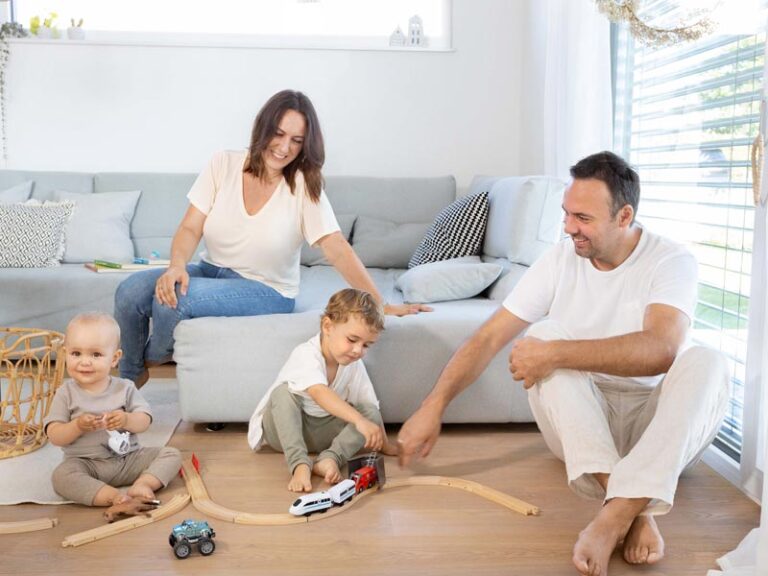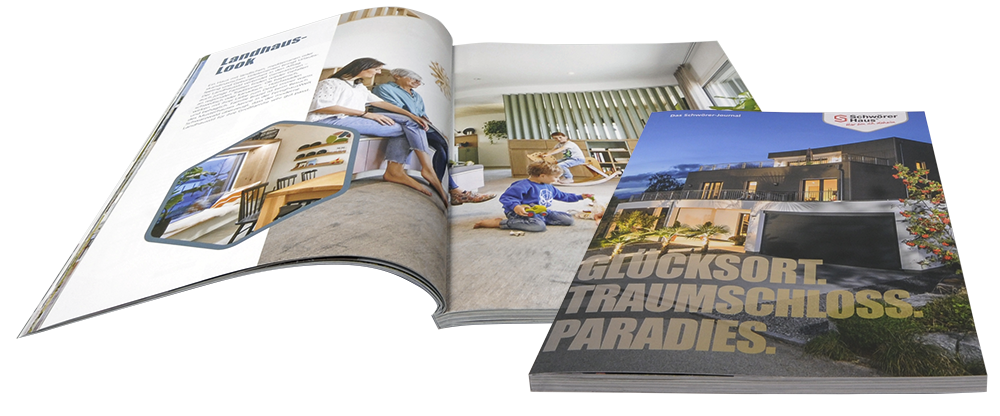







Leading prefabricated house manufacturer
Outstanding quality, attractive design, good price-performance ratio and reliable customer service are our claims – all naturally in consideration of nature and the health of our customers.

Lawnmowers, aeroplanes, footsteps, children’s noise, knocking – even the piano sometimes interrupts your peace and quiet. Noise not only disturbs your subjective well-being and impairs quality of life, it can also make you ill. That is why Schwörer development engineers have taken up this important subject of soundproofing and developed a sustainable, appropriate soundproofing concept for Schwörer prefabricated houses. Especially in new builds, comprehensive soundproofing can take into account the surrounding conditions as well as the individual requirements and circumstances from the outset.
Thanks to their tried and tested stud wall design with a multilayer wall and ceiling structure, Schwörer houses are ideal for soundproofing. Whether you are interested in a home office, studio apartment or semi-detached house: with innovative materials and additional soundproofing measures, we help you to create a quiet home for your family.

Whether external walls, ceilings or windows: Schwörer houses display good soundproofing values, thanks to high-quality building materials and a well-thought out design.
External walls
Brick slips façade: Rw, p = 52 dB
Benefits for you: No stress from external noise
Ceiling
With dry screed above the ground floor: Ln, w, p = 50 dB
Benefits for you: Peace at last
Roof
Pitched roof with full rafter insulation: Rw, p = 49 dB
Benefits for you: More restful living
Windows
Plastic/timber and timber-aluminium design with
triple glazing: Rw, p = 33 dB
Benefits for you: Peaceful sleep

We pursue only one aim with the Schwörer soundproofing concept: the highest quality of life for you. And we give our all for this. Our long-standing material expertise is vitally important here. Close integration between the development department and production ensures that all components are optimally coordinated, and we test the results of our work in the company’s own sound testing laboratory – successfully, as the outstanding soundproofing values make very clear.
Anyone who wants to take action against noise needs to know how it occurs. The sources of noise at home are divided into three areas:
Airborne noise: Sound waves spread through the air, e.g. music, car or aircraft noise.
Impact noise: This occurs when walking on floors or stairs, moving chairs or hopping.
The cement-bonded solid construction material Cospan can be found in all external walls and storey ceilings of Schwörer houses. The material developed by us and produced in our own factory consists of unprocessed wood and cement and, owing to its particular composition, displays a very high internal damping factor which is accompanied by outstanding soundproofing values.
All who want even more peace and quiet in their own four walls should consider installation of our new Schwörer soundproof ceiling. At its core is soundproofing secondary material Crispan, a bulk material that is obtained from Cospan sheet remnants in line with our sustainability principle. In the soundproof ceiling it can be found in honeycomb soundproofing pads, which guarantee improved impact soundproofing at all times.

Schwörer soundproof ceiling with Crispan

Do you want to find out more about our Schwörer houses?
We are happy to send you a free information pack.









Outstanding quality, attractive design, good price-performance ratio and reliable customer service are our claims – all naturally in consideration of nature and the health of our customers.
We are not far from you. With design centres, production sites, but primarily with show homes and building advisors ready to provide comprehensive support.
Our building consultants are available to you for a personal, online video consultation.


Schwörer-Prefabricated Houses
Legal Information
© SchwörerHaus KG | Alle Rechte vorbehalten
Lorem Ipsum is simply dummy text of the printing and typesetting industry. Lorem Ipsum has been the industry’s standard dummy text ever since the 1500s, when an unknown printer took a galley of type and scrambled it to make a type specimen book. It has survived not only five centuries, but also the leap into electronic typesetting, remaining essentially unchanged.